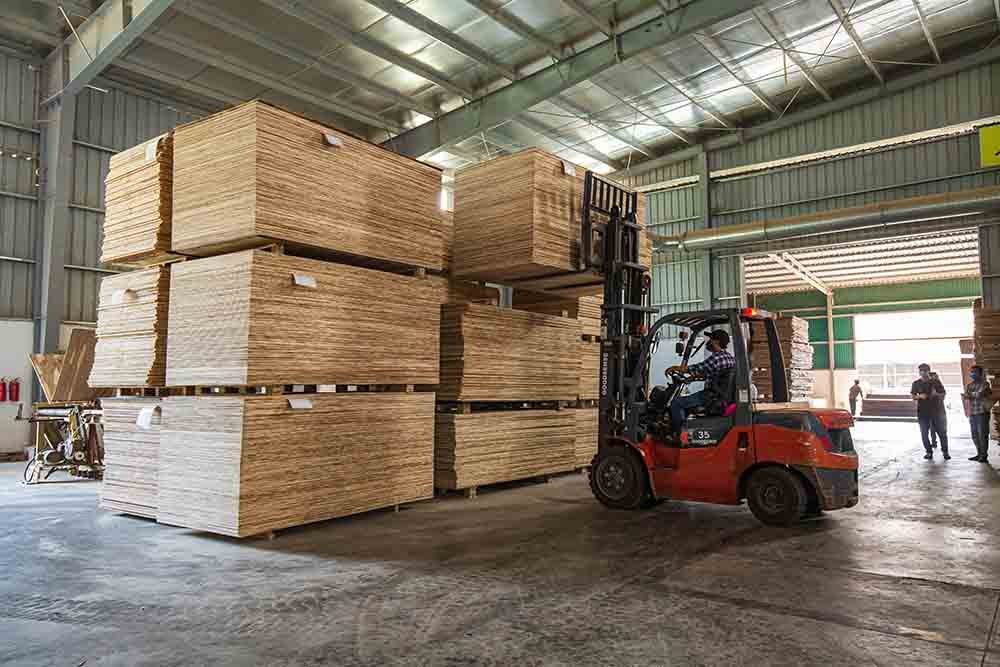Based on demand, we can sort the types of plywood into different groups. Softwood plywood comes from trees like Pine or Birch, etc. On the other hand, hardwood plywood is made from trees such as Eucalyptus, Acacia, Styrax, Okoume, and Birch, etc.
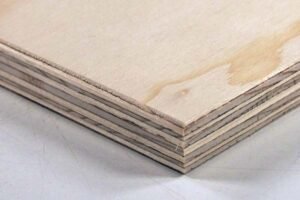
1. Sorting Types of Plywood by Wood Used
1.1. Eucalyptus Plywood
Eucalyptus meeting the U.S. CARB 2 standards has the following specifications:
- Standard Dimensions: 1220mm x 2440mm (4’x8′)
- Face Layer: Imported rotary-cut Eucalyptus A/A, A/B
- Core Layer: Plantation hardwood (Acacia, Eucalyptus, Rubberwood, etc.)
- Adhesive: MR-Ure Formaldehyde E0 standard
- Thickness: 3mm, 5mm, 7mm, 9mm, 12mm, 15mm, 18mm, 25mm
- Tolerance: ± 3%
- Product is moisture and cold water resistant
- Product is not resistant to boiling water and not resistant to termite damage due to storage conditions
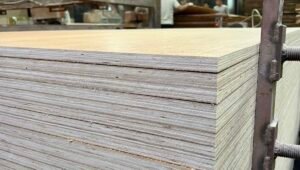
1.2. Acacia Plywood
Acacia meeting the U.S. CARB 2 standards has the following specifications:
- Standard Dimensions: 1220mm x 2440mm (4’x8′)
- Face Layer: Imported rotary-cut Acacia A/A, A/B
- Core Layer: Plantation hardwood (Acacia, Eucalyptus, Rubberwood, etc.)
- Adhesive: MR-Ure Formaldehyde E0 standard
- Thickness: 3mm, 5mm, 7mm, 9mm, 12mm, 15mm, 18mm, 25mm
- Tolerance: ± 3%
- Product is moisture and cold water resistant
- Product is not resistant to boiling water and not resistant to termite damage due to storage conditions
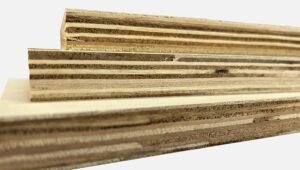
1.3. Styrax Plywood
Styrax meeting the U.S. CARB 2 standards has the following specifications:
- Standard Dimensions: 1220mm x 2440mm (4’x8′)
- Face Layer: Imported rotary-cut Styrax A/A, A/B
- Core Layer: Plantation hardwood (Acacia, Eucalyptus, Rubberwood, etc.)
- Adhesive: MR-Ure Formaldehyde E0 standard
- Thickness: 3mm, 5mm, 7mm, 9mm, 12mm, 15mm, 18mm, 25mm
- Tolerance: ± 3%
- Product is moisture and cold water resistant
- Product is not resistant to boiling water and not resistant to termite damage due to storage conditions

1.4. Birch Plywood
Birch meeting the U.S. CARB 2 standards has the following specifications:
-
- Standard Dimensions: 1220mm x 2440mm (4’x8′)
- Face Layer: Imported rotary-cut Birch A/A, A/B
- Core Layer: Plantation hardwood (Acacia, Eucalyptus, Rubberwood, etc.)
- Adhesive: MR-Ure Formaldehyde E0 standard
- Thickness: 3mm, 5mm, 7mm, 9mm, 12mm, 15mm, 18mm, 25mm
- Tolerance: ± 3%
- Product is moisture and cold water resistant
- Product is not resistant to boiling water and not resistant to termite damage due to storage conditions.

Moreover, you not only see the plywood types we talked about but also find Plywood with different wood coatings on top. These coatings can be Pine, Okoume, Engineered, Ash, Pine, or Sapele wood. However, the kinds we mentioned above are the ones people like best and furniture makers use the most. They’re the go-to choices in the industry and for regular customers buying stuff.
2. Sorting Types of Plywood Based on Surface Coating
2.1. Melamine Coated Plywood
- Standard size: 1220 x 2440mm.
- Thickness 5 – 9 – 12 – 15 – 18 – 21 – 25 mm (or as needed).
- Its core has many layers of natural wood (pine, poplar, spruce, birch) with a thickness of about 1 mm each. The Melamine surface is a layer of decorative paper with Melamine glue about 0.4 – 1mm thick. Melamine has many colors and wood patterns, is super water-resistant, not too expensive and safe to use. People use Melamine in various things such as kitchen cabinets, wardrobes and dressing tables.
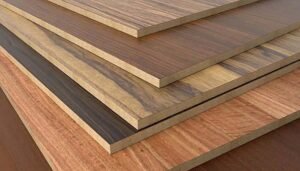
2.2. Laminate Coated Plywood
- Standard sizes of 1220 x 2440mm.
- Thicknesses like 5, 9, 12, 15, 18, 21, and 25 mm (or whatever you need).
- Manufactured on a high-tech production line, laminate (that plastic-y surface) has undergone numerous tests and automated adjustments to ensure that it meets the highest standards. Laminate is often used for home and office furniture because of its properties such as being quite durable – it can withstand impact, water, fire and scratches well. Plus, it is extremely resistant to wear and tear. The surface looks great, is long-lasting and comes in a variety of colors.
2.3. Veneer Coated Plywood
- Standard size: 1220 x 2440mm.
- Thickness 5 – 9 – 12 – 15 – 18 – 21 – 25 mm (or as needed).
- Veneer is real wood cut into thin sheets from 0.3mm to 0.6mm thick. Depending on the wood type, the width is around 180mm, and lengths are about 240mm. Manufacturers usually dry these sheets and put them in the sun. Veneer keeps the best natural look of pricey woods like walnut, oak, and ash. It doesn’t let water in and use for a long time (10-20 years), keeps the natural wood pattern, and doesn’t warp or twist.

3. Plywood production process
The process of plywood production includes the following main steps:
1. Raw material preparation:
Selected timbers are carefully chosen for quality and durability before being expertly cut into precise and suitable-sized blocks for the production process. Each block is checked to make sure it’s good enough to make high-quality sheets.
2. Cutting into thin layers:
Workers feed timber blocks into a high-tech saw. The saw cuts the blocks into super-thin layers called Core/Face Veneer with 1mm thick. The thin layers are then picked for use as both the face and inside parts of the sheets. This ensures the final product looks good and strong.
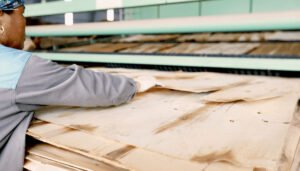
3. Glue application:
The thin wood layers are coated with a special glue to bond the layers together effectively. This is a crucial process for a strong and durable bond between the layers of wood. Each layer is evenly and fully coated to assure a secure and long-lasting bond.
4. Layer stacking and pressing:
After gluing, workers stack them in the pattern they want. They put each layer in a spot that makes the sheet strong and stable. Then, they press the layers together hard. This makes sure the layers stick tight and look the same all over. Pressing doesn’t just make the plywood stronger – it also makes the surface smooth and nice-looking. When workers are careful about stacking and pressing, they end up with a good-quality sheet. This sheet lasts a long time and looks great too.
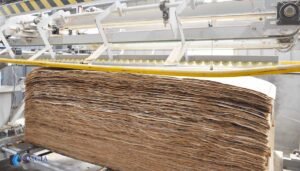
5. Thermal pressing (optional):
The pressing process may be combined with thermal pressing to stimulate the adhesive bonding process, resulting in a final product with higher durability and stability. Heat pressing means putting heat and pressure on the sheets, which makes the glue bond stronger between the layers. This extra step doesn’t just make the plywood stronger and more stable. It also helps it handle different weather conditions better. This makes it a good long-lasting material for building and woodworking projects. By using heat pressing when we make our sheets, we make sure they’re top-quality and work well. This means they meet the highest standards for how good they are and how well they work.
6. Cutting and finishing:
After pressing, the sheet is carefully cut into precise sizes and shapes to meet the specific requirements of different construction and woodworking projects. Each piece is then cleaned up to get rid of any flaws making sure it’s smooth all over. This might mean sanding to make the surface even shining it to show off the wood’s natural look, or putting on a protective layer to make it last longer and stay tough. By focusing on these final touches, we make sure our plywood sheets are not just high-quality, but also look good and professional. This means they’ll make any project they’re used in look even better.
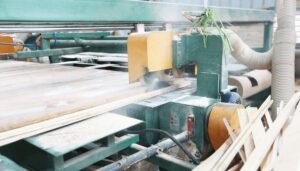
7. Quality inspection:
The final sheets undergo a rigorous quality inspection process to ensure they meet high standards for thickness, durability, and surface quality. Skilled inspectors carefully check for imperfections, inconsistencies, and defects that could compromise the product’s integrity. They assess the thickness, uniformity, and precise measurements to verify structural soundness. Durability is evaluated for heavy loads, environmental conditions, and long-term use. Surface quality is scrutinized for a smooth, flawless finish. Thorough inspections guarantee exceptional quality for customers.
8. Packaging and delivery:
After the sheets pass tough quality checks, we pack them to make sure they get to where they’re going safely. We wrap each sheet so it doesn’t get hurt while moving. We send them to stores for selling or straight to building sites for putting up always trying to give customers what they need. We work hard to pack things and move them . Our aim is to make delivery easy and smooth so our top-notch sheets arrive where they should when they should, looking perfect.
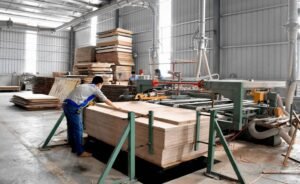
4. Applications of various types of plywood wood include:
Plywood used for outdoor furniture is often made with phenol formaldehyde or melamine urea formaldehyde adhesive, while plywood for indoor furniture typically uses lower-cost adhesives like urea formaldehyde.
Because of their durable and water-resistant structure, they are generally used in interior flooring or CNC partitions, surface-coating furniture implements (desks, wardrobes, beds, and various other related interior furnishing items).
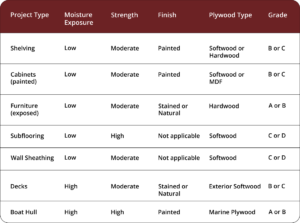
The applications of plywood wood include:
- Interior Decoration: Because of its flexibility and artistic appeal, we can use them as wall, ceiling paneling, and flooring.
- Furniture Manufacturing: Plywood is the main element for manufacturing various types of furniture including cabinets, tables, chairs, and beds due to the strength, durability, and ease of shaping.
- Construction: With structural toughness, water resistance, and cost-effectiveness, plywood is used in construction for making formwork, roofing, sheathing, and subflooring.
- Packaging: With good durability and protection, plywood plays a big role in making crates, boxes, and pallets.
- Transportation: Used for making floors in truck and trailer boat decking, airplane interiors by reason of its lightweight nature and endurance.
- Craftsmanship: Plywood is trusted by artists and craftsmen to create a variety of decorative items, toys, and works of art due to its versatility in cutting, shaping, and finishing.
- Industrial Applications: Fixtures, molds, and tools are main applicants as its stability and resistance to warping.
- Marine Applications: Marine-grade plywood is a product specific to the marine environment and is used in boat building, docks and other marine structures due to its water and rot resistance.
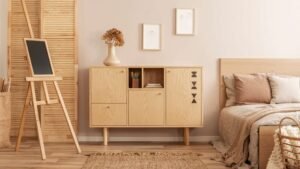
In short, the versatility, durability and cost-effectiveness of this material encourage its popularity and it is suitable for many applications in many different industries.
Not only that, plywood is a material that is currently receiving attention and use in many interior designs, with panel parameters similar to other types of industrial wood (MFC, MDF …). Therefore, it can be used to make all types of furniture and is a popular interior material.
Currently, HPC Vietnam is a leading unit in the production and supply of Plywood materials in the market, ensuring production quality according to European standards. If you have a need for Plywood materials, please contact HPC immediately for consultation and quotation!




